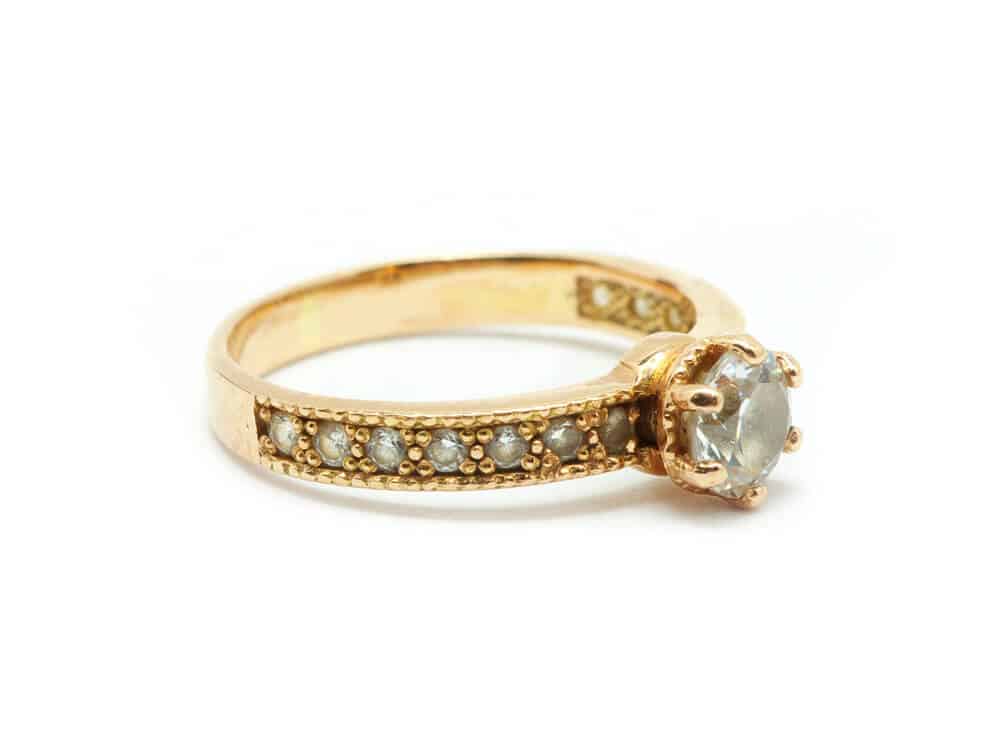
Table of Contents
As Jewelry Shopping Guide editors, we write about things that we love and we think you’ll like too. We often have affiliate partnerships, and may generate some revenue from these links at no cost to you.
Buying a diamond engagement ring comes with a steep price tag attached to it. And if that diamond needs to be a large, flashy center stone, then that price tag goes up even higher. If you, like the rest of us, are on a budget, this can make it really tough to select that perfect stone without having to compromise on size and quality.
But what if you could make your diamond look bigger without having to pay more for it? What if, with a few tricks up your sleeve, you could put your diamond to work for you?
Following is a quick infographic on how to make your diamond appear larger. For more details, keep reading this article, we outline the top tricks to maximizing your diamond without paying more.
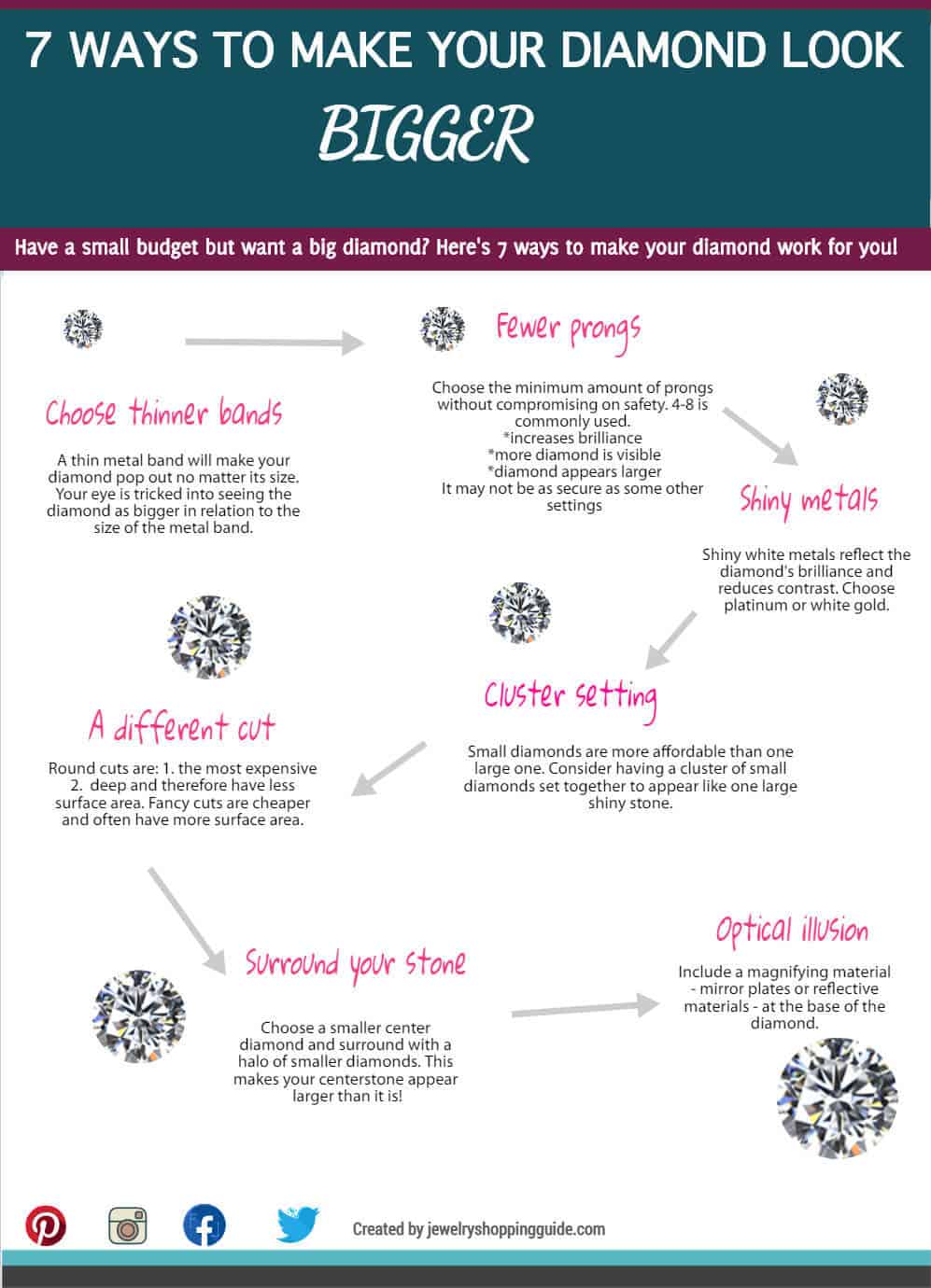
Thinner bands
When selecting your ring setting, choosing a thin band is one easy way to emphasize the diamond and easily make it look bigger. A diamond, no matter what size, when seen against a smaller metal band, will immediately look bigger. This is because you will be comparing the diamond in relation to the size of the metal.
In addition to this, choose a setting that holds your diamond slightly up, as a protruding diamond looks bigger. Solitaire settings such as the Tiffany or cathedral designs are ideal for this.
Take a look at these two diamond engagement rings.
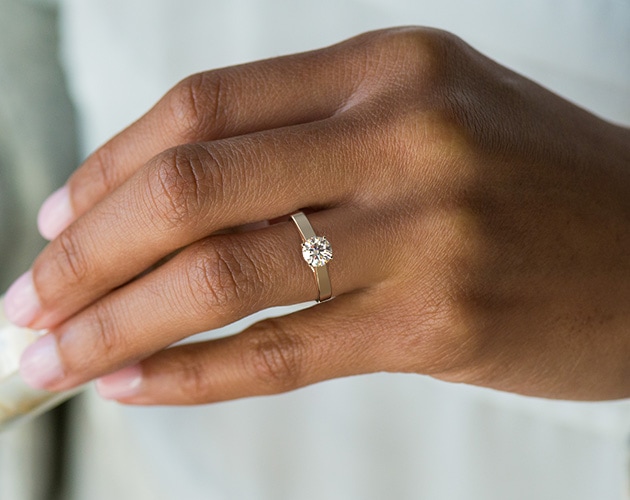
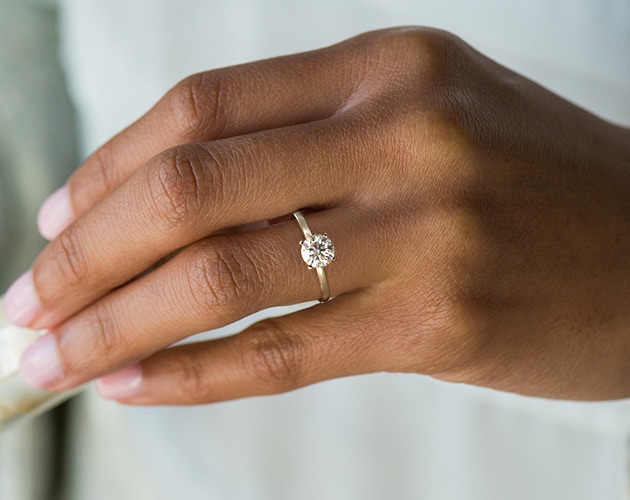
The 1.5mm band easily makes the diamond appear much larger than the 3mm band and highlights the diamond more beautifully.
Fewer prongs
Most diamonds in settings such as solitaire, or Tiffany, are held in place by prongs. These are metal claws that act as fingers to hold the diamond in place. The number of prongs can range from 4 onwards, with 6 or 8 being the most commonly used.
It goes without saying that the more prongs holding your diamond, the more metal surrounding it. This will decrease the amount of diamond that is visible.
It will also reduce the amount of light that is reflected off the stone, decreasing the brilliance of the diamond.
You might be wondering:
But doesn’t fewer prongs mean less security for my diamond?
It is true that the higher the number of prongs, the more securely the diamond is held. Having said that, there is a trade-off between beauty and security when buying a set.
The opposite of a pronged setting would be a setting such as a bezel. While this is extremely secure, it diminishes the brilliance and size of the diamond. Here is an example of a beautiful bezel engagement ring. It’s not necessarily small but it does tend to highlight the metal as much as the diamond.
A 4 pronged diamond setting like this one will show off your stone to maximum effect. Just make sure you buy from a high-quality vendor.
Shiny metals
If you choose a mirror-bright metal like platinum or white gold, this can complement the sparkle of your diamond. It lessens the contrast between the diamond and the metal, making the two almost merge together into one. From a distance, it’s hard to tell where the diamond ends and the metal starts due to the high brilliance of the metal.
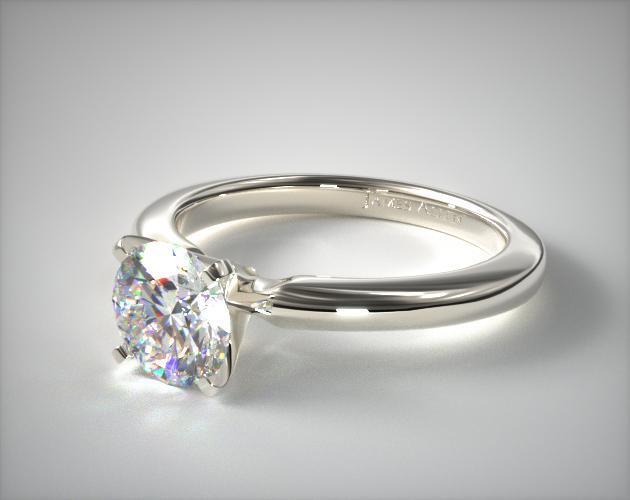
If you choose yellow or rose gold, this will not work as you will clearly be able to see the diamond stand out against the setting.
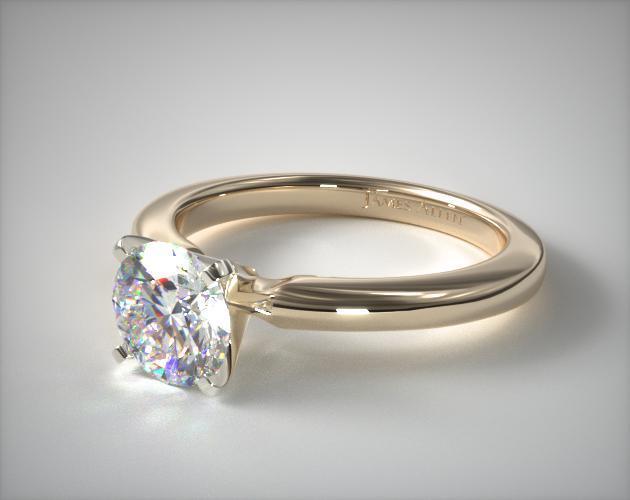
Fancy shapes
While the go-to shape for diamonds is the round brilliant, consider a fancy shape such as an emerald, oval, marquise, or pear. Because the round shape is a very deep cut, a lot of the diamond is actually beneath the surface. Fancy shapes such as emerald or Asscher, for example, are shallower cuts and a lot of the diamond is on the surface, making for a larger diamond. One thing to note, however, is that deep-cut diamonds often have better brilliance and sparkle due to their better light performance.
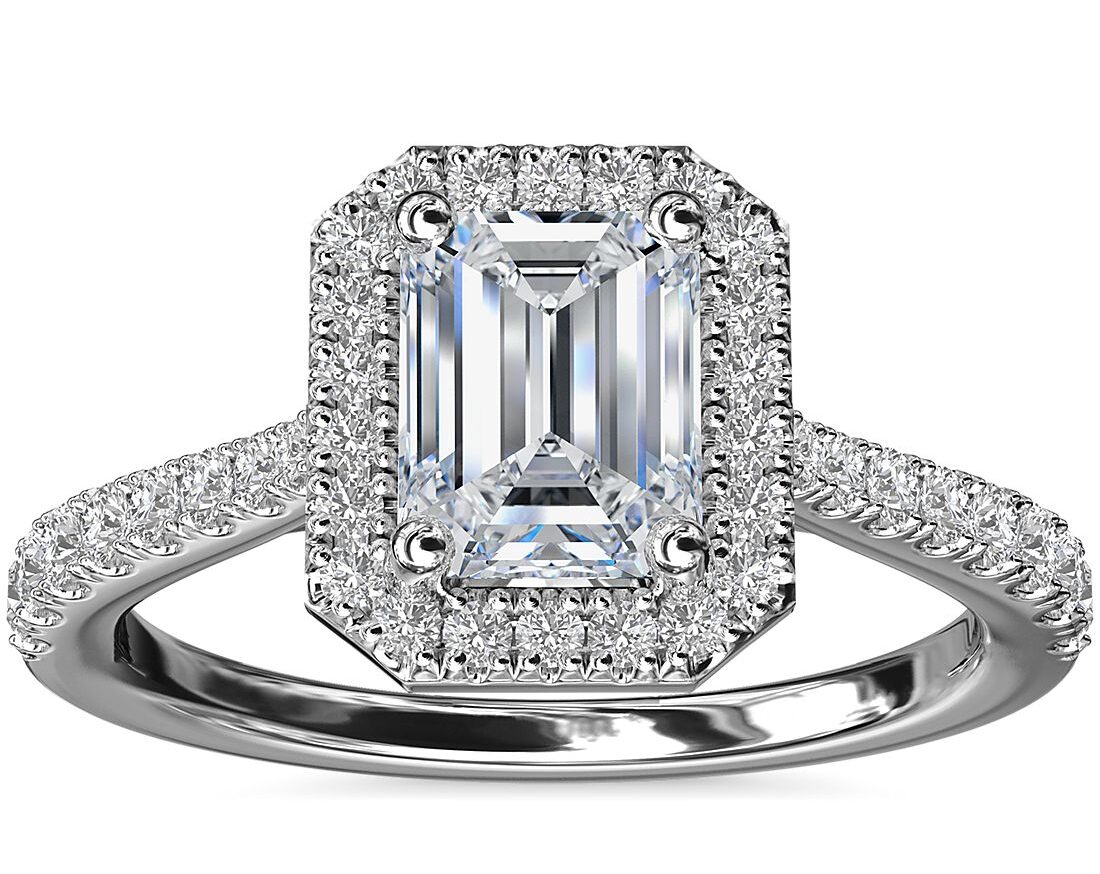
Another practical factor in favor of fancy-cut diamonds is that because fancy shapes are generally cheaper than the round cut, you may even be able to buy a diamond with a larger carat weight without going over your budget.
Tiny diamonds vs. one large diamond
Consider buying a number of small diamonds as opposed to one large diamond. Bearing in mind that the price of diamonds increases exponentially with the increase in carat weight, this trick can actually save you some money.
The best setting for this is the cluster setting. Here, a number of tiny diamonds of the same size and color are set tightly together in a cluster. This ring is an ideal example of how a number of small diamonds create the illusion of one large glittering diamond.
These tiny diamonds, if done correctly, will look like one big diamond. It can be quite hard to tell if this is a cluster from distance. And from up close, the beauty of the diamonds set together is amazing!
Surrounding your diamond
If you really want one large centerpiece diamond, then consider the trick of surrounding it with smaller diamonds. This is called the halo setting and is very popular among engagement ring shoppers.
Instead of buying one large diamond that will break the bank, choose a smaller diamond to act as your centerpiece. This is generally set somewhat higher than the surface and then the diamond is surrounded by smaller similar colored diamonds. These tiny diamonds are very affordable and the setting will make your ring look big, fancy, and attractive.
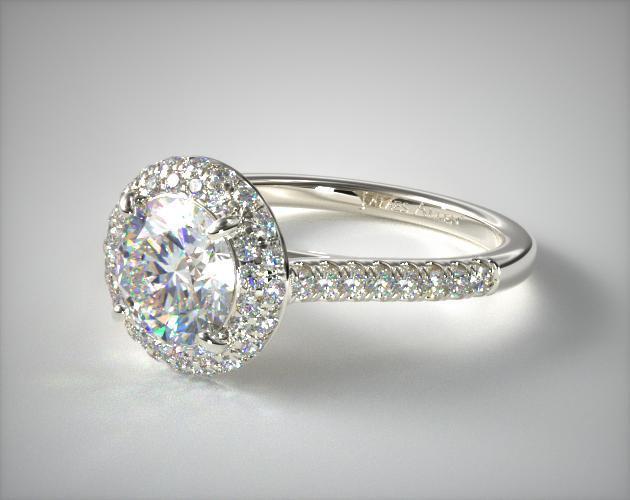
A variation to this is the three-stone ring, where rather than splurge on a large stone, you opt for three smaller stones. The most popular variation of the three-stone ring is a ring with a slightly big diamond in the center and two small diamonds around.
An optical illusion
Jewelers may sometimes include a magnifying material in the base of the setting where the diamond will be mounted, or create the illusion of a bigger diamond using mirror plates or highly reflective metals just around the border of the diamond.
This sneaky little trick makes the diamond look much bigger than its original carat weight. This is the most inexpensive method and it can be difficult to tell if this has been done.
The main worry?
Over time, these materials can lose their luster and sparkle and it can be quite difficult to polish the mirror materials as it would require dismounting the center diamond.
Already bought one?
If you’ve already bought a diamond, don’t worry. There are still ways you can make your diamond stand out.
Always keep it clean and polished. Dirty diamonds can’t reflect light and look smaller and less attractive. Every now and then, you will have to take your diamond to be professionally cleaned by a jeweler to maintain that sparkle.
Keep the focus on the diamond. Dark and shiny nail polish will diminish this focus. Also, avoid wearing multiple bands on your hand while you are wearing your engagement ring. If you must, wear delicate jewelry on the other hand and make sure no other jewelry steals the beauty of your engagement ring.
Ready to check out some amazing engagement rings? Or why not design your own so you’re in control of the look and the cost?
Looking for a ring? Read our quick review on the top online engagement ring retailers.









